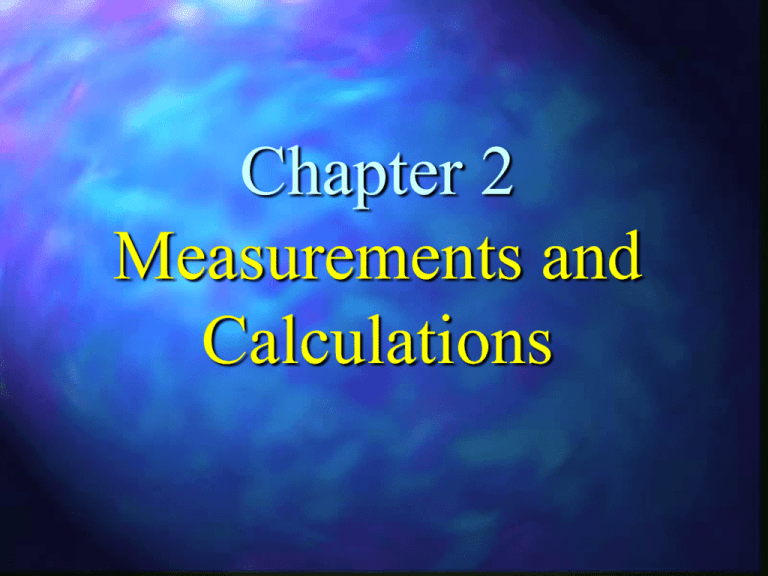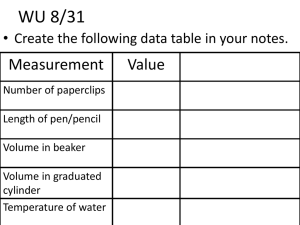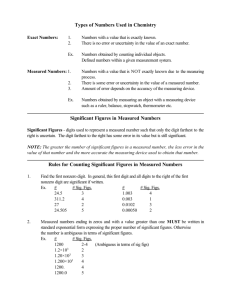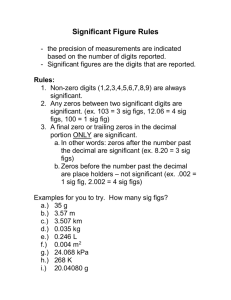Chapter 2
advertisement

Chapter 2 Measurements and Calculations Quiz tomorrow Dimensional Analysis you must know base units and prefixes! Section 2-3 Using Scientific Measurements Accuracy vs. Precision Accuracy - refers to the closeness of measurements to the correct or accepted value of the quantity measured. Precision - refers to the closeness of a set of measurements of the same quantity made in the same way. Accurate or Precise? Percent Error Calculated by subtracting the experimental value (the value you find) from the accepted value (“correct value”), dividing the difference by the accepted value, and then multiplying by 100. % error = Value (accepted) - Value (experimental) x 100 Value (accepted) Calculate the percent error in a length measurement of 4.25 cm if the correct value is 4.08 cm % error = 4.08 cm - 4.25 cm x 100 4.08 cm % error = -4.2% The % error has a negative value because the accepted value is less than the experimental value. If positive, the accepted value is greater than the experimental value. Significant Digits (Also Called Significant Figures – Abbreviated as sig. figs.) Science almost always involves numbers. The numbers you use in math class are exact numbers (they have infinite sig figs). In science, we use measurements, which are NOT perfect numbers. It is important to recognize and report the limitations of measurements along with the magnitude and unit of the measurement. Significant Figures Sig figs are a system where the written number indicates the limit of the measurement. It is vital to include the zeros in your measurement. Sig figs (con’t) These readings indicate the measuring instrument had subdivisions down to the tenths place and the hundredths place is estimated. RULES FOR SIG FIGS 1. All nonzero digits are significant. 2. All zeros between non-zero digits are significant. 3. All beginning zeros are NOT significant. 4. Ending zeros are significant if the decimal point is actually written in but not significant if the decimal is an “understood” decimal. Zeros after nonzero digits after a decimal are significant RULES FOR ROUNDING If digit following last digit to be kept is: Then the last digit should: Example (rounded to 3 sig figs) Greater than 5 Be increased by 1 42.68 g → 42.7 g Less than 5 Stay the same 17.32 m → 17.3 m 5, followed by nonzero numbers Be increased by 1 2.7851 cm → 2.79 cm 5, not followed by nonzero digits and preceded by odd # Be increased by 1 4.635 kg → 4.64 kg 5, not followed by nonzero digits and preceded by even # Stay the same 78.65 mL → 78.6 mL Try the following: How many significant figures are in each of the following measurements? Based on which rule? A. 28.6 g B. 3440. cm C. 910 m D. 0.046 04 L E. 0.006 700 0 kg Adding or Subtracting with Significant Figures The answer for an addition or subtraction problem must have digits no further to the right than the shortest added. Ex. 13.3843 cm 1.012 cm +3.22 = 17.6163 = 17.62 cm Multiplying or Dividing with Significant Figures For multiplication or division the answer must have the same number of sig figs as the factor with the least number of sig figs. Example: (3.556 cm) (2.4 cm) = 8.5344 cm2 = 8.5 cm2 EXAMPLE PROBLEMS A. 5.44 m – 2.6103 m = ? B. 2.4 g/mL x 15.82 mL C. What is the sum of 2.099 and 0.05681 g? D. Calculate the area of a crystal surface that measures 1.34 micrometers by 0.7488 micrometers Assignment Significant Figures Scientific Notation Numbers written in scientific notation follow the format M x 10n M = a number greater than or equal to 1 and less than 10. n = any whole number. For Example To write the number 65 000 km (2 significant figures) in scientific notation it would be 6.5 x 104 km M in this case is 6.5 (2 sig. figs.) n in this case is a positive value because 65 000 is a large number. Another Example If you write a very small number in scientific notation such as 0.000 12 mm, (2 sig. figs.) in scientific notation it would be expressed as 1.2 x 10-4 mm. M in this case is 1.2 (2 sig. figs) N in this case is negative because 0.000 12 is a very small number. Rules for writing in Scientific Notation. 1. Determine M by moving the decimal point in the original number to the left or right so that only one nonzero digit remains to the left of the decimal point. Keep all sig. figs. 2. Determine n by counting the number of places that you moved the decimal point. If you moved it to the left, n is positive. If you moved it to the right, n is negative. A (Somewhat) Useful Mnemonic Think of a registered nurse carrying an oldfashioned record album (an RN with an LP): right = negative left = positive Assignment 2.3 Worksheet – Due Tues. BOP Working with Scientific Notation – Due Wed. BOP








